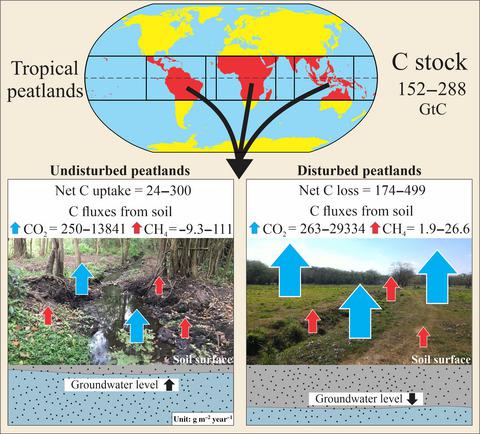当前位置:
X-MOL 学术
›
Glob. Change Biol.
›
论文详情
Our official English website, www.x-mol.net, welcomes your
feedback! (Note: you will need to create a separate account there.)
Tropical peatlands and their contribution to the global carbon cycle and climate change
Global Change Biology ( IF 10.8 ) Pub Date : 2020-10-18 , DOI: 10.1111/gcb.15408 Kelly Ribeiro 1 , Felipe S. Pacheco 1 , José W. Ferreira 1 , Eráclito R. Sousa‐Neto 1 , Adam Hastie 2 , Guenther C. Krieger Filho 3 , Plínio C. Alvalá 1 , Maria C. Forti 1 , Jean P. Ometto 1
Global Change Biology ( IF 10.8 ) Pub Date : 2020-10-18 , DOI: 10.1111/gcb.15408 Kelly Ribeiro 1 , Felipe S. Pacheco 1 , José W. Ferreira 1 , Eráclito R. Sousa‐Neto 1 , Adam Hastie 2 , Guenther C. Krieger Filho 3 , Plínio C. Alvalá 1 , Maria C. Forti 1 , Jean P. Ometto 1
Affiliation

|
Peatlands are carbon‐rich ecosystems that cover 185–423 million hectares (Mha) of the earth's surface. The majority of the world's peatlands are in temperate and boreal zones, whereas tropical ones cover only a total area of 90–170 Mha. However, there are still considerable uncertainties in C stock estimates as well as a lack of information about depth, bulk density and carbon accumulation rates. The incomplete data are notable especially in tropical peatlands located in South America, which are estimated to have the largest area of peatlands in the tropical zone. This paper displays the current state of knowledge surrounding tropical peatlands and their biophysical characteristics, distribution and carbon stock, role in the global climate, the impacts of direct human disturbances on carbon accumulation rates and greenhouse gas (GHG) emissions. Based on the new peat extension and depth data, we estimate that tropical peatlands store 152–288 Gt C, or about half of the global peatland emitted carbon. We discuss the knowledge gaps in research on distribution, depth, C stock and fluxes in these ecosystems which play an important role in the global carbon cycle and risk releasing large quantities of GHGs into the atmosphere (CO2 and CH4) when subjected to anthropogenic interferences (e.g., drainage and deforestation). Recent studies show that although climate change has an impact on the carbon fluxes of these ecosystems, the direct anthropogenic disturbance may play a greater role. The future of these systems as carbon sinks will depend on advancing current scientific knowledge and incorporating local understanding to support policies geared toward managing and conserving peatlands in vulnerable regions, such as the Amazon where recent records show increased forest fires and deforestation.
中文翻译:

热带泥炭地及其对全球碳循环和气候变化的贡献
泥炭地是富含碳的生态系统,覆盖地球表面的185-4.23亿公顷。世界上大多数泥炭地位于温带和北方地区,而热带泥炭地仅覆盖90-170 Mha的总面积。但是,碳储量估算仍存在相当大的不确定性,并且缺乏有关深度,堆积密度和碳积累速率的信息。尤其是在南美的热带泥炭地中,数据不完整尤其明显,据估计这些泥炭地是热带地区最大的泥炭地面积。本文展示了围绕热带泥炭地的当前知识状态及其生物物理特征,分布和碳储量,在全球气候中的作用,人为直接干扰对碳积累率和温室气体(GHG)排放的影响。根据新的泥炭扩展和深度数据,我们估计热带泥炭地可储存152–288 Gt C,约占全球泥炭地排放碳的一半。我们讨论了在这些生态系统中的分布,深度,碳储量和通量研究方面的知识差距,这些知识差距在全球碳循环中发挥着重要作用,并有可能向大气中释放大量温室气体(CO2和CH 4)受到人为干扰(例如排水和森林砍伐)时。最近的研究表明,尽管气候变化对这些生态系统的碳通量有影响,但直接的人为干扰可能起更大的作用。这些系统作为碳汇的未来将取决于不断发展的科学知识,并结合当地的理解来支持旨在管理和保护脆弱地区泥炭地的政策,例如最近的记录显示森林大火和森林砍伐加剧的亚马逊地区。
更新日期:2020-10-18
中文翻译:

热带泥炭地及其对全球碳循环和气候变化的贡献
泥炭地是富含碳的生态系统,覆盖地球表面的185-4.23亿公顷。世界上大多数泥炭地位于温带和北方地区,而热带泥炭地仅覆盖90-170 Mha的总面积。但是,碳储量估算仍存在相当大的不确定性,并且缺乏有关深度,堆积密度和碳积累速率的信息。尤其是在南美的热带泥炭地中,数据不完整尤其明显,据估计这些泥炭地是热带地区最大的泥炭地面积。本文展示了围绕热带泥炭地的当前知识状态及其生物物理特征,分布和碳储量,在全球气候中的作用,人为直接干扰对碳积累率和温室气体(GHG)排放的影响。根据新的泥炭扩展和深度数据,我们估计热带泥炭地可储存152–288 Gt C,约占全球泥炭地排放碳的一半。我们讨论了在这些生态系统中的分布,深度,碳储量和通量研究方面的知识差距,这些知识差距在全球碳循环中发挥着重要作用,并有可能向大气中释放大量温室气体(CO2和CH 4)受到人为干扰(例如排水和森林砍伐)时。最近的研究表明,尽管气候变化对这些生态系统的碳通量有影响,但直接的人为干扰可能起更大的作用。这些系统作为碳汇的未来将取决于不断发展的科学知识,并结合当地的理解来支持旨在管理和保护脆弱地区泥炭地的政策,例如最近的记录显示森林大火和森林砍伐加剧的亚马逊地区。









































 京公网安备 11010802027423号
京公网安备 11010802027423号